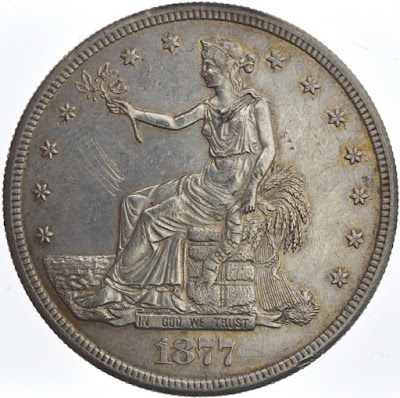

United States Trade Dollar dated 1877 S
Obverse: Liberty seated on a pile of bricks in front of a sheave of wheat. She holds an Olive branch in her extended right hand and a Liberty banner drapes from her left hand. There are 13 stars arrayed around the denticled rim, and the date is centered at the bottom of the coin.
The reverse design shows a rampant eagle clutching three arrows in his right talon and an olive branch in his left. The inscription "420 GRAINS .900 FINE" appears below the eagle. A banner contains the motto "E PLURIBUS UNUM" above the eagles head. "UNITED STATES OF AMERICA" and "TRADE DOLLAR" circle the outside of the reverse. Mint marks are centered below the eagle between the weight and the trade dollar legend.
Years Minted: 1873-1885
Mints: Philadelphia, San Francisco, Carson City
Composition: 0.900 silver, 0.100 copper
Diameter: 38.1 mm
Weight: 27.22 grams (0.7878 ounces of silver)
Total Mintage: 35,954,535
Edge: reeded
The Trade dollar was born out of the fight between silver and gold as the monetary standard. The monetary act of February 12, 1873 established the gold dollar as the unit of value for the US monetary system. Silver was only authorized for use in fractional coinage (dimes, quarters and halves) and in “Trade Dollars”. Further, the law allowed that silver money could only be used for legal tender up to five dollars.
The trade dollar was issued for circulation in the orient to compete with dollar–sized coins of other countries (primarily Mexico). The trade dollar weighed 420 grains of 0.900 fine silver, giving it a pure silver content of 378 grains, one grain more than the competing Mexican coin. This weight advantage appealed to the Chinese merchants that readily accepted the coins.
To combat counterfeits, many pieces that circulate in the Orient were counter stamped with Oriental characters, known as “chop marks”. A guarantee of authenticity and weight by the merchant applying the “Chop”. This latter became an issue for redemption as some of the Chops were actually gouged into the coin making them underweight!
During the years they were being produce, Trade dollars were legal tender in the United States. It was worth $1.05 in gold in 1873 but with the decline in silver prices their value began to fall and by 1876 they were worth only 83 cents. Acceptance in commerce at face value became an issue.
In 1878 the Bland Allison Act discontinued the coinage of trade dollars and authorized the standard dollar which was to be accepted at face valued even though it contained only 90 cents worth of silver. Congress authorized the Treasury to limit coinage to export demand. In 1887, the treasury redeemed all trade collars that were not mutilated. The law authorizing Trade dollars was repealed in February of 1887.
Mint records indicate the 44,148 Trade dollars were melted on July 19, 1878 (the last year when substantial numbers of trade dollars were minted) many of these are believed to have been 1878 CC issues. Small numbers of trade dollars (1-2 thousand per year) continued to be manufactured in Philadelphia as specimen proofs and recorded in mint records through 1883. In the early 1900s a number of coins dated 1884 and 1885 surfaced. These are not listed in the mint directors reports and hence are not believed to be part of the regular mint issue.
Varieties to the Trade dollar design include:
Reverse 1: Berry under Eagles left Talon; Arrowhead ends over 0. Used on all coins from all mints in 1873 and 1874, and occasionally in 1875 and 1876.
Reverse 2: Without extra berry under the talon; Arrowheads ends over 2. Used occasionally at all mints from 1875 through 1876 and on all coins from all mints 1877 through 1885.
Obverse 1: Ends of scroll points to left; extended hand has only three fingers. Used on all coins at all mints 1873 through 1876.
Obverse 2: Ends of scroll point downward; hand has four fingers. Used in combination with Reverse 2 on one variety of 1876s, and on all coins at all mints from 1877 through 1885